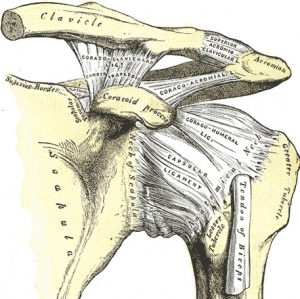Acromioclavicular Joint
Original Editor - Tyler Shultz
Lead Editors - Your name will be added here if you are a lead editor on this page. Read more.
Description[edit | edit source]
The Acromioclavicular Joint, or AC joint, is one of four joints that compose the shoulder complex. The AC joint is formed by the junction of the lateral clavicle and the acromion process of the scapula, and is a gliding, or plane style synovial joint. The AC joint serves as the main articulation that suspends the upper extremity from the trunk, and it is at this joint about which the scapula moves[1].
Motions Available
[edit | edit source]
Motions of the Scapulothoracic joint are generally considered to be a combination of sternoclavicular and acromioclavicular motions.[2] The motions of the AC joint are described as scapular movement with respect to the clavicle, including[3]:
- Upward/downward rotation about an axis directed perpendicular to the scapular plane facing anteriorly and medially.
- Internal/External rotation about an approximately vertical axis.
- Anterior/Posterior tipping or tilting about an axis directed laterally and somewhat anteriorly.
Ligaments and Joint Capsule
[edit | edit source]
The AC joint capusle and ligaments surrounding the joint work together to provide stability and to keep the clavicle in contact with the acromion process of the scapula.
Joint Capsule: The AC joint has a thin capsule lined with synovium, which is strengthened by capsular ligaments both inferiorly and superiorly. Without the superior and inferior capsular ligaments, the AC joint capsule would not be strong enough to maintain the integrity of the joint.[4]
Ligaments:
- Coracoclavicular Ligaments[5]: Composed of the conoid and trapezoid ligaments (which do not actually come in contact with the joint), this combined ligament is the primary support ligament of the AC joint. The coracoclavicular ligaments run from the coracoid process to the underside of the clavicle, near the AC joint. These ligaments combribute to horizontal stability, making them crucial for preventing superior dislocation of the AC joint, both portions also limt rotation of the scapula. The most critical roll of the coracoclavicular ligament is in producing the longitudinal rotation of the clavicle necessary for full ROM during elevation of the upper extremity.
- The Conoid Ligament is the fan shaped component of the coracoclavicular ligament. It is located more medailly than the trapezoid ligament.
- The Trapezoid Ligamentis the more lateral portion of the coracoclavicular ligament, and is quadrilateral in shape.
- The AC Ligament serves to reinforce the joint capsule and serves as the primary restraint to posterior translation and posterior axial rotation at the AC joint.[6]
Muscles[edit | edit source]
The Clavicle serves as an attachment for many of the muscles that act on the upper extremity and head, these inlude:
- Pectoralis Major (Clavicular head)
- Sternocleidomastoid
- Deltoid
- Trapezius
Closed Packed Position[edit | edit source]
The closed packed position of the AC joint occurs when the GH joint is abducted to 90 degrees.
Open Packed Position[edit | edit source]
The open packed position of the AC joint is undetermined.
Other Important Information[edit | edit source]
Resources[edit | edit source]
- Dutton, M. (2008). Orthopaedic: Examination, evaluation, and intervention (2nd ed.). New York: The McGraw-Hill Companies, Inc.
- Levangie, P.K. & Norkin, C.C. (2005). Joint structure and function: A comprehensive analysis (4th ed.). Philadelphia: The F.A. Davis Company.
Recent Related Research[edit | edit source]
Failed to load RSS feed from http://eutils.ncbi.nlm.nih.gov/entrez/eutils/erss.cgi?rss_guid=1FuuOtUS4LZ28aX6oq6sGkDdUT_BXF1bfUXzDcka2jNiMu9Qn|charset=UTF-8|short|max=10: Error parsing XML for RSS
References
[edit | edit source]
- ↑ Dutton, M. (2008). Orthopaedic: Examination, evaluation, and intervention (2nd ed.). New York: The McGraw-Hill Companies, Inc.
- ↑ Inman, V.T., Saudners, J.B., Abbot, L.C. (1996). Observations of the function of the shoulder joint. 1944. Clin Orthop Relat Res. 3-12.
- ↑ Teece, R.M., Lunden, J.B., Lloyd, A.S., Kaiser, A.P., Cieminski, C.J., Ludewig, P.M. (2008). Three-dimensional acromioclavicular motions during elevation of the arm. J Orthop Sports Phys Ther. 38(4), 181-90.
- ↑ Levangie, P.K. and Norkin, C.C. (2005). Joint structure and function: A comprehensive analysis (4th ed.). Philadelphia: The F.A. Davis Company.
- ↑ Levangie, P.K. and Norkin, C.C. (2005). Joint structure and function: A comprehensive analysis (4th ed.). Philadelphia: The F.A. Davis Company.
- ↑ Turnbull, J.R. (1998) Acromioclavicular joint disorders. Med Sci Sports Exerc, 30, S26-32.
</div>







